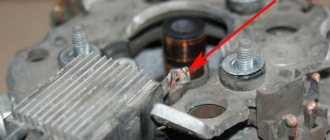Constant undercharging of the battery or its absolute discharge at the most inopportune moment is a headache for many car owners. One source of these problems may be the generator. But how to check it? Perhaps it's not his fault at all? Let's figure out together how much the generator must produce for the normal functioning of all car systems and maintaining the battery in a charged state.
How to check the operation of the generator
The battery in a car is an important element of the system, which is responsible for providing the car’s on-board network with electricity. The generator is used to charge the battery while it is active. Unstable operation of a device generating electricity causes a voltage drop in the network and failure to restore the capacity of the power source.
Normal generator performance means timely and complete replenishment of the battery charge level, which decreases under load. Checking the battery charge level from the generator is simple and can be done by the car owner himself.
Diagnostics of an automotive energy-generating device includes a visual inspection of the unit, its elements and related parts, as well as voltage and current measurements. At least twice a year, you should check the tension of the drive belt, excessive weakening of which leads to a decrease in the performance of the generator, and sometimes can lead to breakdown of the device. Once a year, you can check equipment elements - fasteners, diode bridge, voltage regulator and others. Timely maintenance of the battery will also guarantee the absence of problems - cleaning the terminals, adding distilled water.
Diagnostics of indicators such as voltage, current, resistance are also necessary twice a year. To carry it out, you will need special devices - a voltmeter, multimeter or load fork.
Reasons for failure
If the symptoms described below appear, carry out diagnostics. You can do it yourself or take the car to a car service. To determine the cause of the failure, special equipment is needed. If you decide to figure it out yourself, master a multimeter tester.
Five possible sources of difficulty are described below:
bearing wedge (lubricant is used up, sometimes the belt breaks - you will need to replace or rebuild the unit);
the winding has burned out (a common cause is the reagents used to treat winter roads);
brush wedge (reason – wear of graphite cores);
the regulator relay is faulty (this element prevents the battery from overcharging and stabilizes the voltage);
The diode bridge is broken.
What kind of charging should go to the battery from the generator?
It is traditionally believed that 13.5-14.5V should be supplied by the generator to the battery and this is absolutely enough to replenish the battery costs.
It is worth considering that using a battery with a higher power in a car than the manufacturer recommends also requires the installation of a more productive generating device.
It is necessary to take into account the load that the generator must withstand - it is calculated based on the maximum indicators of all electrical appliances and car systems.
Do not forget that the charging current from the energy-generating device will allow you to start the car in the cold season. In order to avoid problems with starting the car, we recommend purchasing generating equipment, the charge current of which will be approximately 10% of the capacity of the power source. That is, a battery of 100 A/h requires a generator that can produce 10A. Please note that for many cars, 100 amp equipment will operate at its maximum capacity, because the power consumption of the automotive system is in the region of 80 amps. Therefore, the choice of a source generating energy must take into account both the battery capacity and network consumption.
A few words about electrolyte
One of the main indicators by which you can judge the health of a battery is the electrolyte level. The voltage of the power supply depends on it under different operating modes.
In the process of discharging the battery, acid is consumed, the share of which in the total volume of liquid is a third (35-36%).
The result is a decrease in the density of the liquid. When the battery is charged, the reverse process occurs.
In such a situation, water is consumed, and acid, on the contrary, is formed. As a result, the density of the electrolyte increases.
In the normal state, when the battery voltage is 12.7 V, the density is 1.27 g/cc. Moreover, all parameters directly depend on each other.
How to check the alternator voltage on the battery
The potential difference can be diagnosed in two ways - directly at the generating equipment and through the battery. The generator is directly connected to the power source with a thick wire, therefore, to check the level of potential difference, you can measure the voltage at the power source. To do this, you will need special devices - a voltmeter, multimeter or load plug.
The wires of the first measuring instruments are connected to the battery in any sequence. The plug must be connected to the battery terminals with strict observance of polarity. It is generally accepted that the normal voltage in the network should not be lower than 12 volts. At idle speed without turning on all the electrical appliances of the car, this indicator should be at the level of 13.5-14V. A drop in voltage values to 13.3-13.8 volts is considered acceptable.
At the same time, using conventional testing equipment, you can check the resistance of the generator elements - rotor, stator and diode bridge. Diagnostics of rotary equipment is carried out by its winding. It is necessary to connect the probes of the device with slip rings. If the multimeter gives readings from 2, 3 to 5.1 ohms, then this element is working. The current consumption of the winding should be within 3-4.5 amperes.
Its normal resistance is 0.2 Ohm. The diode bridge is checked by the presence or absence of resistance, the indicators do not matter. The only thing worth considering is that there should not be a zero dimension. Measurements are carried out in pairs - positive output and all plates on this side or minus and all elements.
We remind you that for normal charging of a car battery, the voltage supplied by the generator must be from 13.5 to 14 volts.
Useful tips
- It is not advisable to use the capabilities of the on-board PC to measure the voltage on the battery. The result will differ from the true value due to the specifics of connecting the computer to the on-board network. Therefore, errors cannot be avoided. And approximate data, taking into account some variation in parameters, will tell the car owner little.
- This is how you can verify the normal operation of the generator and the good condition of the battery. Turn off all consumers and start the engine. What voltage should be depending on this is a sign that the battery is 100% charged. The multimeter should show about 13.6±1. Then, one by one, one of the electrical network devices turns on. For example, headlights, then low beam. Each of the electrical devices “reduces” the voltage by 0.2. But in total - no less than 12.8. Otherwise the battery will drain quite quickly.
- Even if the battery meets all the described requirements, a comprehensive check should be carried out regularly. A good battery should “hold” voltage. If the car has not been used, and, for example, after a few days the multimeter shows a value significantly lower than in the previous test, then the battery is already “at its limit.” You need to be especially careful with her.
The author draws attention to the fact that all recommendations are rather approximate and generalized. But it is precisely these simple techniques that allow even inexperienced car owners to understand the condition of the battery, whether the generator is working and how correctly the battery is being recharged. For a more detailed study of all components of the on-board electrical network, you need to contact specialists.
How many amperes does a car alternator produce per battery?
The current strength required by the electrical system of each car is individual and depends on the number of electricity consumers and their values. And also the charge current must be sufficient to charge the power source.
It is worth noting that ampere readings appear only when there is a load in the vehicle’s electrical system and, accordingly, the battery is discharged. After starting the car engine, the charging current is about 6-10 amperes and drops over time, because the battery is charging, taking on the main energy consumption. If you turn on additional equipment - headlights, radio or heated mirrors, you can see an increase in the charging current values.
When purchasing a generator, pay attention to its technical characteristics, which the manufacturer indicates on the case - that’s where you will find information about the maximum current that will flow to the battery.
In the table below you can see the approximate current values that the generator shows at different loads.
Table 1. How many amperes the generator produces under load.
Engine running
on the battery with the engine running (less than 13) - evidence that the battery charging mode does not correspond to the norm. What could be the reasons?
Firstly, in the battery itself. Resource depletion and sulfation are the main problems that car owners most often encounter.
Secondly, either the generator is not working well, or there is a malfunction in the electrical circuit. For example, increased leakage current with decreased insulation resistance. As a rule, defects in the braiding of wires that lead to breakdown and short circuit.
Thirdly, there is a problem with contacts. This should be checked immediately. Remove the terminals, inspect them and the battery terminals for oxidation. If necessary, clean and tighten fasteners tightly.
Signs of a generator malfunction
In modern cars, breakdowns of the electrical system are one of the most common. A large number of electronics requires particularly careful monitoring of the operation and condition of the generator and battery, because their failure can immobilize the car. The most common signs of a generator malfunction are:
- battery indicator light on the instrument panel;
- unstable operation of the battery (its boiling over or undercharging);
- different intensity of headlights;
- extraneous sounds from the generator.
If you notice incorrect operation of the car, then perhaps the battery charging current from the generator is insufficient.
All malfunctions of electrical equipment, which includes the vehicle’s energy-generating device, are mechanical (deformation or breakage of fasteners, housing, malfunction of bearings, pressure springs, drive belt, etc.) or electrical (winding breaks, diode bridge malfunctions, burnout or wear of brushes , short circuits between turns, breakdowns, etc.).
Don’t write off a non-working generator: find out if there are repair kits and spare parts. Replace them if possible. If you cannot carry out repair work yourself, then take the generator to a workshop. Many craftsmen will be able to restore the unit at no extra cost and in the shortest possible time.
However, some breakdowns require the purchase of a new device that generates electricity. For example, a failing bearing that is soldered into the generator housing cannot be restored or replaced in most cases.
Remember that failure of this unit can be caused not only by wear and corrosion, but also by poor quality of elements and components; excessive load; external influence of salts, liquids, temperatures.
Rectifier module
The rectifier module is designed to convert alternating current into direct current. It is based on six silicon diodes (gates): three positive and three negative. They are located on two horseshoe-shaped plates. To smooth out voltage surges, the terminals of the positive and negative diodes are connected through a 2.2 μF capacitor.
How to check the generator on a VAZ-2110 for the functionality of the rectifier unit with your own hands? To do this, you will need a regular car tester or test lamp. The essence of the test is based on the ability of diodes to pass current in only one direction. A faulty valve either does not pass current at all, or passes in both directions.
So, first you need to remove the casing of the rectifier unit. Next, connect the first wire of the test lamp to terminal “B” of the generator, and the second to the ground of the device. If the unit is working properly, the lamp should not light up. If it lights up, there is a short circuit in the rectifier and it needs to be replaced.
Don't be lazy to check the capacitor as well. Turn the tester into ohmmeter mode (1-10 MOhm) and measure its resistance. For a working capacitor, it should first take a minimum value and then gradually increase. If this does not happen, replace the capacitor.
NET.Gadget
Articles
How to check amps with a multimeter? annotation
A multimeter is a device that is used to measure voltage, current, resistance, and test wires. In other words, this device is quite necessary. With all this, as practice shows, it is quite popular not only in the industry, but also in everyday life.
Alas, once a competent installation is carried out and how to proceed with the necessary measurements, it should be taken into account that a multimeter. Not a completely safe device. If used incorrectly, of course, it will not only simply disable it, but also cause severe harm to one’s own health. This is especially true in cases where your company needs to take measurements at high voltage or high current. It won't be difficult to just immediately burn the multimeter and get severe electrical injury.
That’s why, before you can properly install and start using a multimeter, you need to practice on power sources with low current ratings, for example, batteries. It is also not recommended to misuse the instructions for the device.
Types of multimeters
First you need to know that multimeters are digital and analog (pointer, even among electricians they are known as “tseshka”). The latter have been known to electricians for a long time, but it is quite difficult to use them without special knowledge and practice.
- you need to be able to understand the scales of the device, of which there are several on the dial multimeter;
- The device should be kept in a position where the needle on it will not “walk” along the scale.
That's why, if possible, it is better to use a digital multimeter. We will also consider examples with the implementation of a specifically digital device, because it is quite difficult to learn how to work with analog multimeters without the help of others.
There are quite a few varieties of digital multimeters, but the principle of their operation is similar to each other - the difference lies solely in the number of functions of the device. Accordingly, the cost also depends on the functionality of the multimeter, so before you get it, decide why you need it.
The multimeter consists of:
- the device itself;
- 2 probes (dark and reddish);
- power source (9 V Krona battery).
So, what are the features of using this measuring device and how?
Instructions
In order to measure the current in a circuit, you need to connect the device to it one by one. With all this, on the multimeter itself you need to plug a reddish-colored probe into the socket on the device labeled mA, and a dark one into com. A serial connection means that the circuit must be broken and each probe is connected to a different wire, i.e. the device must be connected between 2 power sources. But because you are measuring current strength, and this is simply impossible to do in power supplies, you need to include a certain device in the circuit, for example an ordinary light bulb, placing it in the circuit immediately after the power source.
How can you simply check your charger
multimeter. Watch my other videos from the useful category.











